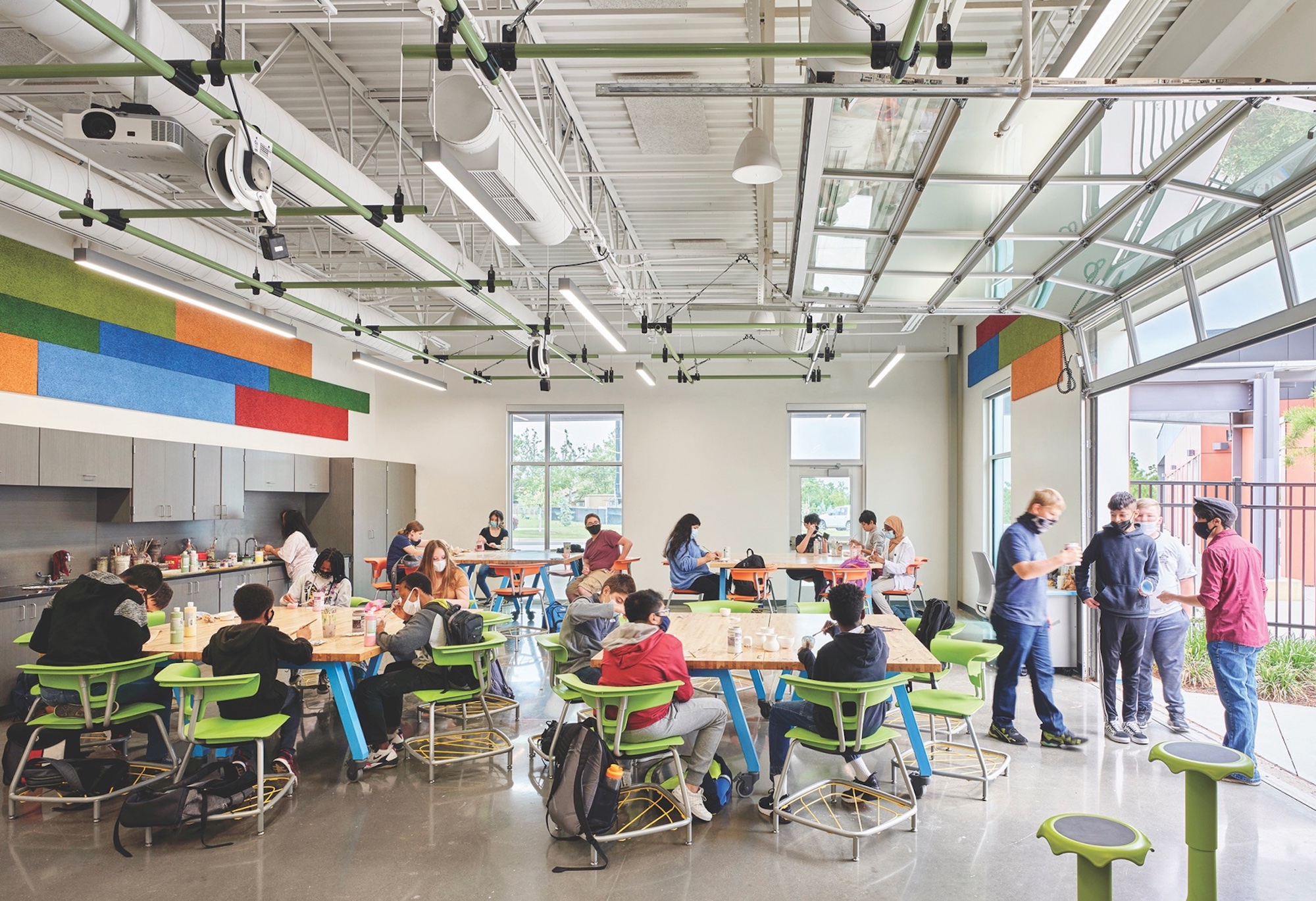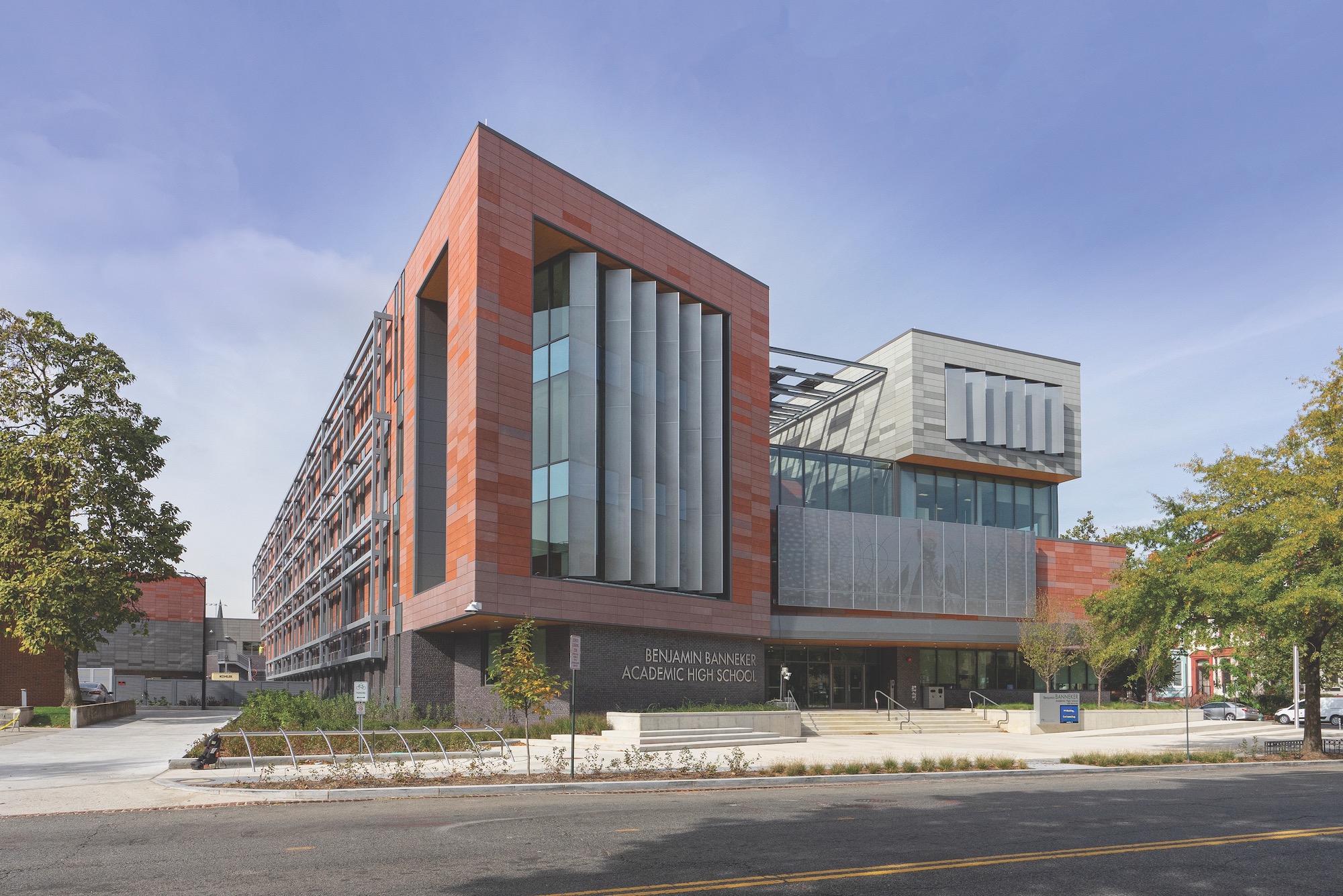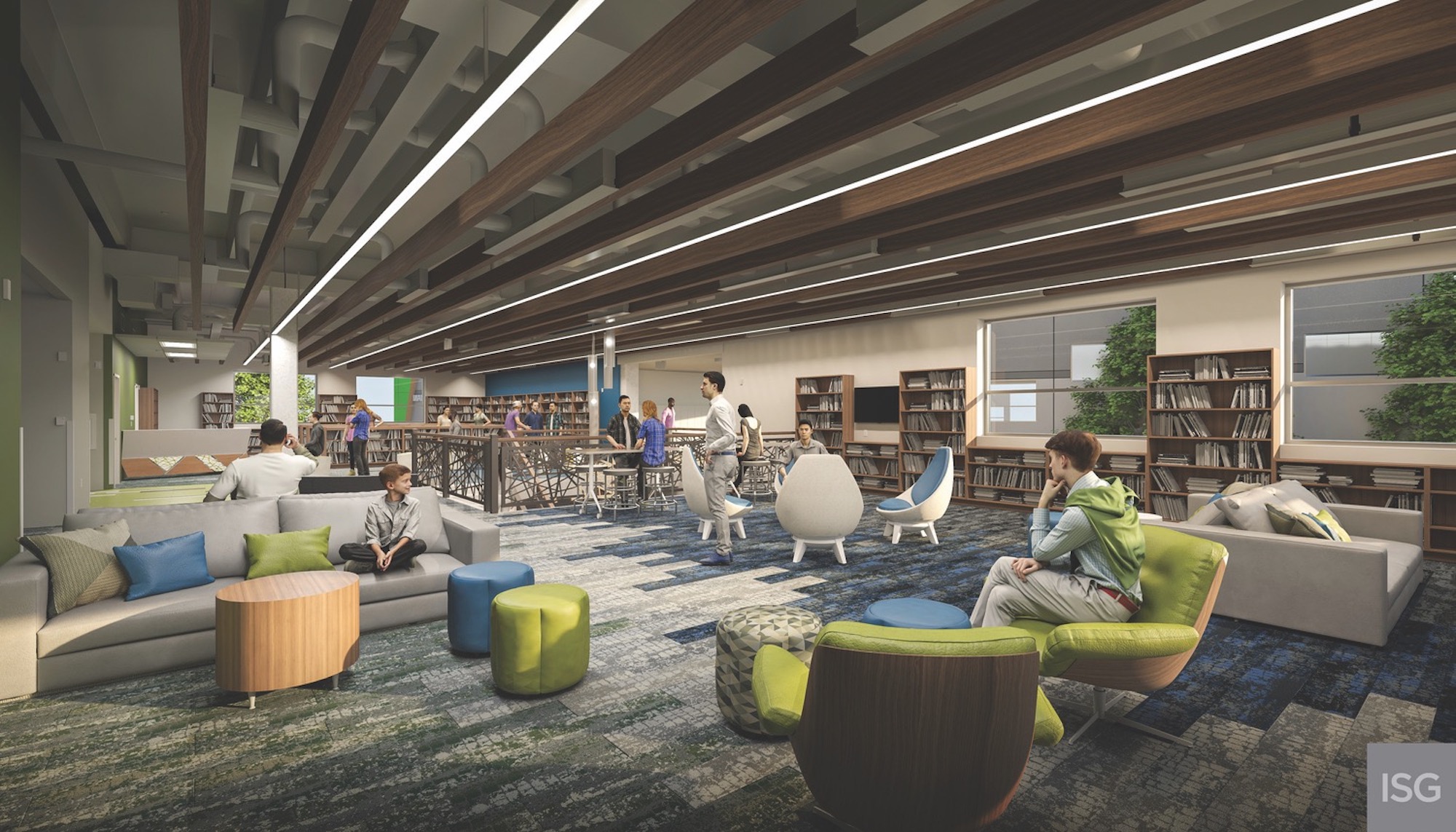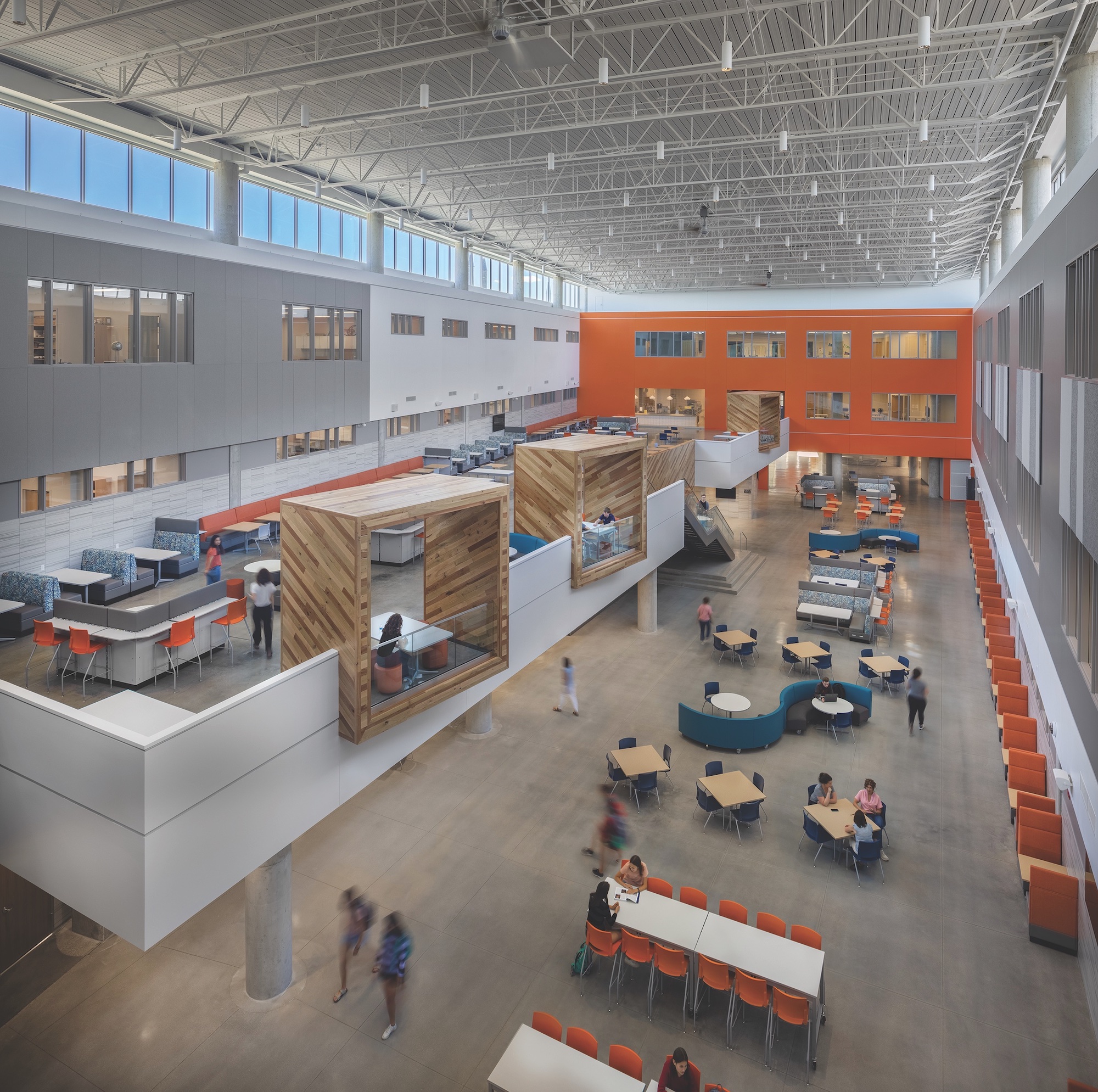During the past year, general contractor Findorff started work on more than $300 million in large-scale renovations for one of Wisconsin’s largest K-12 school districts. That work includes $70 million in each of the district’s four comprehensive high schools, significant improvements to a smaller community-based high school, and the construction of a new elementary school to improve structure equity in the district.
The global design firm DLR Group has been seeing more community and school-district interest in adaptive reuse, specifically in transforming vacant retail, warehouse, and other large-volume spaces into educational environments, according to K-12 Education Design Leader Todd Ferking, AIA.
While new construction comprises a sizable portion of AEC firms’ K-12 work, renovations and adaptive reuse are often the preferred modernization options for school districts and municipalities. “The majority of our K-12 work is still very renovation heavy. Much of the K-12 infrastructure isn’t feasible to replace, nor is replacement always necessary,” says Vaughn Dierks, AIA, LEED AP, Partner in Charge at Wold Architects + Engineers. One of his firm’s recent design examples is White Bear Lake (Minn.) High School, a reuse of the original core buildings with major interior reconfigurations, new additions, and systems replacements.
The choice between renovation or new construction often comes down to land, agree Skanska executives in five markets—Seattle, Portland, Ore., Tampa, Boston, and Cincinnati—who responded to BD+C’s questions. New construction makes up the majority of Skanska’s K-12 projects in the Pacific Northwest, Massachusetts, and Ohio, whereas renovations are more common in Florida. “No matter what the region, for school districts with available land, we see more new construction, while those without land are relying on renovations, adaptive reuse, or demolishing and replacing facilities,” the firm states.
However, as Christin Misna, Findorff’s Director of Education Market, notes, new construction still makes sense when schools consolidate in reaction to enrollment declines, or when a building has reached the end of its lifespan, or if the costs of repairs or renovations exceed the benefits of building new.
Balancing security and wellness in K-12 schools
Regardless of whether the project is new or a rehab, school districts prioritize safety and security of students, faculty, and staff. In one of its large high school replacement projects, Skanska is demolishing an existing school, which is only 40 years old, because its campus was designed in an open California style with multiple entrances. “The new high school is designed to create a single entrance point for a controlled, safe campus,” explains Trevor Wyckoff, Skanska’s Vice President and Account Manager in Oregon.

“Safety is at the forefront for every design decision, scope option, logistical consideration, and program for a K-12 project,” assert Jason Santor and Travis Coombs, the construction firm CORE’s Director of Preconstruction in Arizona and Vice President in Nevada, respectively.
The safety measures that AEC firms say are being designed or built into K-12 schools include impact-resistant glass at interior and exterior glazed entrances that provide visibility to gathering spaces, secure vestibules that might also include video surveillance, landscape design that limits hiding places for perpetrators, lockdown zones with strategic door hardware schedules to hinder access to classrooms and shelter-in-place spaces, and “conceal spots” within the school where students can protect themselves.
That being said, AEC firms are designing schools, not jails, points out Wold’s Dierks. While many AEC firms and their clients continue to follow Crime Prevention Through Environmental Design (CPTED) principals, they’ve also made efforts to balance safety with wellness. “There is a major focus to incorporate principles such as natural surveillance, territorial reinforcement, natural access control, maintenance, lighting, and landscaping,” say three executives from the design firm Orcutt|Winslow who responded to BD+C’s questions.
DLR Group’s Ferking has observed a shift toward designing for social and emotional health, so that bullying and violent behavior can be stanched, and students in distress can be more easily identified.To those ends, technology plays an increasingly important operational role for K-12 schools. “Technology is no longer an option in schools; it’s a requirement,” says Susan Tully, Gilbane Building Company’s K-12 Education Leader. She’s seeing more demand for robust wireless infrastructure, and the installation of new communication systems into existing schools.
The proliferation of mobile interactive flatscreen monitors is giving schools the flexibility to use spaces like cafeterias and gyms as teaching stations, observes Tina Stanislaski, a Principal with Cambridge, Mass.-based HMFH Architects. What has surprised the executives at Orcutt|Winslow is that, after two years of COVID-induced remote learning, which some districts predicted would be transformative, teachers are once again leaning toward interpersonal and even analog learning methods. “People are starved for human connection, and there does not seem to be a digital replacement,” the firm’s execs say.
Technology upgrades are probably most evident in schools’ indoor air quality and acoustics. Arlington (Va.) Public Schools contracted the engineering and building performance consultant CTMA to provide an analysis of the district’s classrooms to ensure they met ASHRAE air quality and ventilation standards. The district spent $500,000 on upgrades, new filters, and equipment that included more than 2,000 Certified Air Cleaning Devices that CMTA installed, confirms Tony Hans, the firm’s Vice President.

Washoe County (Nev.) School District, which has been on a school building binge over the past six years, realized that it needed to pay more attention to acoustical performance throughout all spaces, and particularly in music rooms and multipurpose rooms, say CORE’s executives, whose firm has worked with the district on a number of school projects.
Acoustical issues “are often overlooked” in school design, says Mark Quattrocchi, FAIA, Principal at Quattrocchi Kwok Architects, and such oversights can be detrimental to comprehension, communications, and student wellbeing. QKA typically retains a consulting acoustical engineer to advise on its K-12 construction and renovation projects.
Skanska’s Highline High School project, which is near Seattle’s Sea-Tac International Airport, received an FAA grant to cover the cost of acoustic elements to dampen aircraft noise. Skanska worked with an acoustical consultant to determine potential solutions, which resulted in value engineering the roof of the school’s 400-seat theater that was constructed using a perforated cellular acoustical deck and multiple layers of drywall.
Exposing K-12 school students to the outdoors
When HMFH installs HVAC systems into schools, it typically favors displacement ventilation in lieu of air conditioning. Displacement ventilation supplies 100% outdoor air that never recirculates, says Stanislaski, who adds that there’s less upfront cost because the system has fewer moving parts that require maintenance.
This choice accentuates how school projects are creating more access to the outdoors for social distancing, comfort, cognitive alertness, and as a learning tool. “We are starting to see this,” says Shane Butler, Kraus Anderson’s Construction Executive and Senior Project Manager. Two of his firm’s recent construction management projects—the preK-12 Red Rock Central and North Park School for Innovation, both in Minnesota—will feature outdoor classrooms.
SEE ALSO:
• Top 160 K-12 School Sector Architecture and AE Firms for 2022
• Top 70 K-12 School Sector Engineering and EA Firms for 2022
• Top 100 K-12 School Sector Contractors and CM Firms for 2022
CORE has seen multiple districts creatively integrate the outdoors into their schools via roll-up doors, courtyard spaces, and exterior amphitheaters. Its executives point specifically to the Eagle Valley Middle School addition being constructed for the Carson City (Nev.) School District, which incorporates an architectural masonry wall that serves as a projection screen, an exterior learning stair, and a garden.
“We typically work with our landscape architects to design various outdoor educational spaces” that include hands-on gardens, wetlands labs to study plants and animals, and green roofs for outdoor science labs and health classes, says HMFH’s Stanislaski. “These connections need not complicate design or construction, but do expand learning spaces at minimal cost to the project budget.”
Proposed and existing mandates drive sustainability in school construction
HMFH is among the AEC firms that districts are asking to make their schools more sustainable by reducing their energy, water, and waste. Districts are trying to stay ahead of municipal, state, and federal mandates that are calling for net-zero energy in new construction. Districts are also reframing sustainability as more than a checklist of requirements for resource conservation to where the discussion revolves around the wellbeing and needs of students and the community, say DLR Group’s Ferking and Gilbane’s Tully.

One of HMFH’s projects, the Annie E. Fales Elementary School in Westborough, Mass., is the first net-positive energy public school in New England. Another project, Bristol County Agricultural High School, is the first Massachusetts public school to use composting toilets, which helped cut the school’s water use in half even as enrollment increased by 40%. And a third, Arlington High School, is one of Massachusetts’ largest all-electric carbon-free public high schools.
CTMA has designed 36 net-zero energy K-12 schools across the U.S. Hans says that as early into a school’s planning stage as possible, his firm sets sustainability goals for the project that include energy reduction, occupant health and wellness, and building certification targets. “This immersive process allows the team to look beyond standard systems and create a holistic picture of the whole building concept before the design is developed, ensuring the sustainable features are incorporated and maintained during construction,” says Hans.
Skanska recently completed an energy management program for Hillsborough Public Schools in Florida. With more than 270 buildings, “the district’s energy bill is substantial,” says Daniel Abou-Jaoude, Vice President and Account Manager for Skanska’s Florida operations. The program included a district-wide, $100 million energy retrofit for LEDs and lighting controls that cut the district’s energy bill by 35-40%, which Abou-Jaoude says translates into $30 million in savings per year.
Related Stories
| Aug 11, 2010
Cherokee Nation center employs eco-friendly features
Three new schools for K-12 students are the focus of a $108 million, 473,000-sf Cherokee Nation multipurpose complex based in Cherokee, N.C. Designed by Padgett & Freeman Architects and built by BE&K Building Group, the center was designed to reflect the art and heritage of the Cherokee people, evidenced by the seven-sided shape of the two courtyard areas and traditional basketweave pat...
| Aug 11, 2010
Replacement school puts old school's materials to good use
Replacing an existing school in the University School District near St. Louis, Mo., the new Barbara C. Jordan Elementary School will accommodate up to 500 students in 24 classrooms. The $13 million school spans 64,834 sf and will use recycled elements from the old building, including mosaic tiles from water fountains, an entryway tile mural, and a freestanding masonry bench.
| Aug 11, 2010
Hillside school sports exciting shape
An education facility for 1,200 students and 300 teachers will grace a hillside in the Faroe Islands town of Torshavn. The 19,200-sm Faroe Islands Education Centre, designed by Copenhagen-based Bjarke Ingels Group, will have a panoramic view overlooking the sea, mountains, and harbor. The building's vortex shape radiates toward its surroundings while drawing attention to the center of the school.
| Aug 11, 2010
New Union City school to use remnants from old building
With 35 classrooms, a media center, science labs, and music rooms, Columbus Elementary School #3 in Union City, N.J., is being built on a confined site, so designer RSC Architects, in conjunction with HOK, will implement underground parking and a rooftop playground. RSC Architects also salvaged classical porticos from a former school at the site; they will be reused to create dramatic entryways...
| Aug 11, 2010
High-density planning allows abundant open space
Gilroy Unified School District's new Christopher High School in California opened its first phase this fall. The 1,800-student, 231,000-sf facility was designed with a high-density site plan that allows for both on-site sports fields and undeveloped open space. BCA Architects of Fremont, Calif., with Gilbane Building Companies as CM, collaborated with numerous user groups to plan the two-story,...
| Aug 11, 2010
And the world's tallest building is…
At more than 2,600 feet high, the Burj Dubai (right) can still lay claim to the title of world's tallest building—although like all other super-tall buildings, its exact height will have to be recalculated now that the Council on Tall Buildings and Urban Habitat (CTBUH) announced a change to its height criteria.
| Aug 11, 2010
Courtyard connects new and remodeled schools
Good Fulton & Farrell Architects of Dallas designed a major expansion and renovation at the Dallas Academy in Texas. The 22,900-sf addition serves as the school’s new front door and includes a library, student assembly area, cafeteria, seven classrooms, and administrative offices. The school’s existing 14,560-sf building was renovated to accommodate a lower school component, and...
| Aug 11, 2010
Connecticut high school gets a expansion and renovation
The Morganti Group, Danbury, Conn., is managing the construction of a $41 million addition and renovation project at Newtown (Conn.) High School. Designed by Fletcher Thompson, Shelton, Conn., the project consists of a 70,000-sf addition and 30,000 sf of renovations to the gymnasium and interior spaces.
| Aug 11, 2010
School district plans net-zero building
Camas (Wash.) School District is planning to utilize one of three energy sources—photovoltaics, wind turbine, or geothermal—to help take its new community high school completely off the grid. The school district commissioned Interface Engineering to explore all three options for the project, which is scheduled to break ground in August.
| Aug 11, 2010
LA high school takes design cue from historic Mexican architecture
The Los Angeles Unified School District recently opened the $75 million Felicitas and Gonzalo Mendez Learning Center, a high school in the Los Angeles neighborhood of Boyle Heights, near Little Tokyo. Designed by Nadel Architects in a joint venture with Barrio Planners Inc., the 114,000-sf school is vertically integrated, allowing the campus to fit on a compact, six-acre site.







